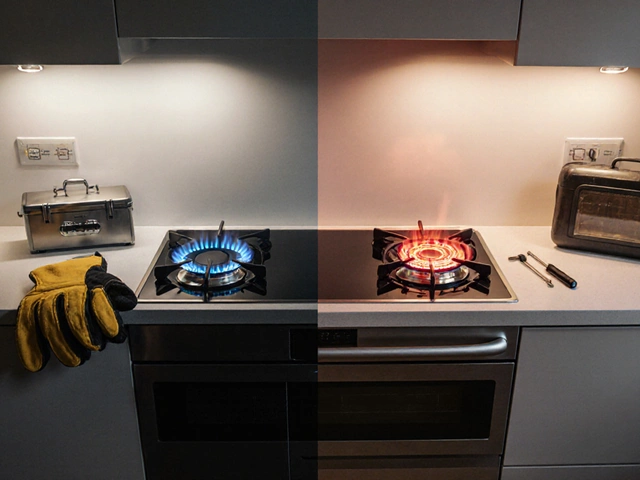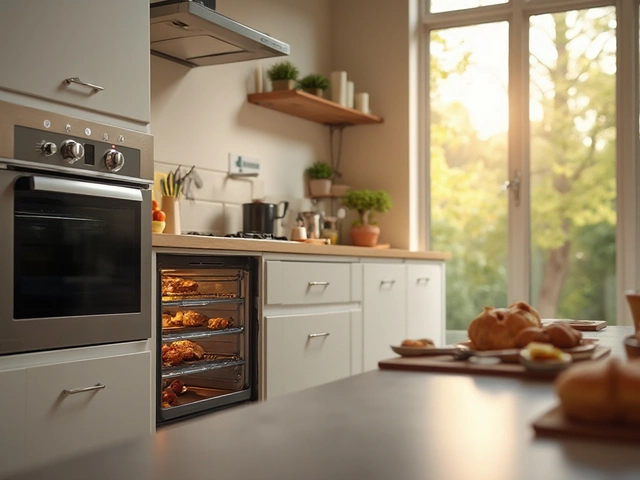You flick a switch, and something whirs to life. Magic? Not really. If you've ever stared at a dishwasher during a cycle and wondered, "How does it even know what to do?", you're not alone. People live with their appliances for years before they finally realize they have no clue what's actually happening inside those sturdy plastic shells. Turns out, each little beep, rumble, and click is the result of carefully-engineered technology doing its job. Let's peel back the shiny covers and see what's actually going on.
Unraveling the Mystery: The Core Mechanisms of Popular Appliances
Take the washing machine—probably the hardest-working machine in any family home. It doesn't just fill with water and spin. The basic process actually starts with a water inlet valve that opens when you press start. Cold and hot water streams in, controlled by a temperature sensor that makes sure your delicate stuff doesn't get boiled. The detergent drawer is more than a fancy compartment; some modern machines spray water directly through your detergent to make a cleaner, sudsier mix before any clothes get wet. The inner drum, full of holes, starts turning thanks to an electric motor at just the right speed to mimic you hand-washing but way faster and way more efficient. Sensors keep everything balanced—if Finn stuffs his school jerseys all on one side, the washer will notice and pause to redistribute the load so it doesn't walk itself across the laundry room. During the rinse cycle, powerful pumps send dirty water out while fresh water surges in for a clean finish. Since energy efficiency matters now more than ever, most new machines in 2025 are clever about using only as much water and power as needed per batch—some can even detect the fabric type!
The real magic is in the electronics. The control board, basically a tiny computer, decides things like how long to spin, when to drain, and how to protect your clothes from tangling. Interestingly, a study from Consumer NZ in 2024 found that the top reason for breakdown among Kiwi washing machines wasn’t the motor, but the electronic board—proof that these "brains" matter as much as brawn in modern appliances.
If you peek inside a vacuum cleaner, you'll find a totally different system working towards a single goal: suction. Most uprights use a powerful electric fan that spins at thousands of revolutions per minute, creating an area of low pressure. Air (and dirt) rushes in to fill the low-pressure space and gets trapped by filters. Some vacuums go even further, using cyclonic separation first made famous by James Dyson, which spins air in a cone so centrifugal force flings heavier dirt outward. That’s how you get those clear chambers filling with gunk instead of bags ripping open under the kitchen table.
Don’t forget the fridge—a domestic staple and the most misunderstood. A modern refrigerator cools with a process called vapor compression. The heart is a compressor, squeezing refrigerant gas till it heats up. That gas zooms through coils on the fridge’s outside, releasing its heat (that’s why the sides feel warm). Then it turns into a liquid, enters inside-coils, absorbs heat from your food, and turns back into a gas. It repeats this endlessly. A thermostat in the fridge watches the temperature and switches the compressor on and off to keep things steady. Since global refrigeration accounts for roughly 17% of all household energy use, engineers are pushing for fridges to use smarter, more eco-friendly refrigerants that don't warm the planet.
Microwaves really are a marvel of modern physics. They don't cook from the inside out (contrary to what people say at barbecues), but zap food with electromagnetic waves that jiggle water molecules. The friction heats things up super quick. The wave generator is called a magnetron; it was originally invented during WWII for radar. Newer microwaves use inverter technology to adjust power smoothly, so you don’t get dry edges and cold centers. That’s been a big upgrade for reheating leftovers—goodbye crusty pizza!
Hidden Sensors and Smart Features: How Tech is Changing Appliances
Appliances today aren’t just motors and metal. They’re loaded with sensors that gather data every second. Dishwashers are a great example. Older models timed out the wash with a simple mechanical dial, but most units now have soil sensors. These sensors measure how dirty the rinse water is and decide if another round is needed. Finn once left a chunky spoon in the dishwasher, and the sensor flagged that something wasn't right with the wash—so it ran an extra cycle. Saved us from having to listen to Maya remind everyone to rinse before loading.
Many modern dryers use humidity sensors. Instead of running a preset timer, they shut off as soon as your towels are actually dry. That saves on power and saves your fabrics from frying. In the kitchen, induction cooktops work their magic with magnets, not flames or glowing coils. A copper coil under the glass creates a magnetic field. If you use a pot that’s iron-based (no aluminum!), the field induces tiny electric currents in the pot metal, generating heat right where you need it: in the pan itself, not spilling out the sides. That makes induction far safer and more efficient than gas or traditional electric stoves.
Fridges have even started monitoring their own health. Some brands offer interior cameras so you can check what’s inside from your phone at the supermarket. It’s honestly helpful—not just for curious tech nerds. And if you ever see that little icon blinking on your fridge display, it could be warning you the door’s been left open too long, or reminding you to swap the water filter. Smart sensors can even alert you to possible breakdowns before you notice a puddle under the vegetable drawer.
Let’s look at smart ovens—seriously, these are a thing now. They use temperature probes to make sure your chicken reaches precisely 75°C (the Food Safety Authority standard to kill salmonella here in New Zealand). With a WiFi connection, you can start preheating on the way home or get a nudge if you forget the roast. Voice assistants and app-based controls have gone from sci-fi to Saturday night routine. It’s never been this easy to avoid burning dinner—even if you’re wrangling a toddler.
The ultimate power of these smart features is not just convenience—but efficiency. According to a 2023 report by the International Energy Agency, homes with smart appliances and usage monitoring cut electricity bills up to 18% compared to standard models. That’s real savings you can notice when the quarterly bill arrives.

Tips and Hacks: Making Your Appliances Last and Perform Better
We all want our gadgets to last, but how you treat your appliances makes a massive difference. First, always read the manual—not just for setup, but for cleaning routines and little maintenance tasks. Finn thought running the washing machine empty on hot was enough, but manufacturers like Bosch and Fisher & Paykel recommend regular drum cleaning cycles with a special cleaner to avoid mold and keep sensors clear.
For fridges, dust the coils behind or underneath every six months. Dirty coils make the compressor work harder, using more power and breaking sooner. If you can, leave a bit of space between the fridge and the wall for better air flow. And don’t overload—fridges cool better when air flows between items. Maya’s tip: group similar foods together to find things faster and close the door quicker. Saves both time and icy hands.
Vacuum cleaners are another one people forget. Empty the dust bin when it’s only half full for maximum suction. Wash or replace filters every few months. If you have a stick vacuum, check for tangled hair and string around the brush roller—this kills battery life and can burn out the motor. I actually keep a small pair of scissors in the cleaning closet for exactly this purpose. A clogged brush reduces pickup by up to 30% according to vacuum testing labs.
Microwaves get grotty fast. Use a bowl of water with lemon juice and run it for 3 minutes to loosen grime before wiping (and it smells amazing). Never run a microwave empty—there’s nothing for the waves to heat, which can damage the magnetron. When reheating, arrange food in a ring or use the edge of the plate, not the center, for more even results.
Don’t ignore error codes. Almost every modern appliance will try to tell you what’s wrong. Keep a list of codes handy, or check the manufacturer's website for quick troubleshooting. Sometimes it’s as simple as a door not closed fully or a blocked hose.
Here’s something practical: use appliances during off-peak electricity times. In Auckland, power is cheapest late at night or early morning. Set dishwashers or washing machines to run at 3am—just check your neighborhood’s noise rules first!
According to a tech support survey from 2024 found in the table below, most common appliance issues are surprisingly easy to fix at home:
| Appliance | Common Issue | DIY Fix Rate |
|---|---|---|
| Washing Machine | Blocked filter | 74% |
| Vacuum Cleaner | Clogged hose | 82% |
| Microwave | Door not closing | 61% |
| Fridge | Dirty coils | 89% |
"The more informed the owner, the longer their appliance lasts. A little bit of knowledge triples appliance life." — HomeTech Review, March 2024
Why Understanding Appliances Matters: The Real-World Impact
It’s not just about saving a few bucks or impressing your mates at a BBQ. Knowing how your appliances work makes a real difference in daily life. For starters, it lets you catch problems early—strange noises, blinking lights, or a new smell are much less scary when you know what the machine’s trying to tell you. When our dryer started leaving clothes damp, I realized the humidity sensor was caked with lint—a five-minute clean fixed what could have been a $200 repair. Would I have noticed if I hadn’t spent time understanding what my appliances did? Probably not.
appliance working principle isn’t just a bit of trivia to toss around. It’s how you know what to watch for, what to clean, and when to actually call a pro. These machines are part of the fabric of modern family life—freeing up hours so you can spend more time messing about with your kids, or catching up on the rugby, rather than scrubbing dishes by hand. And when you do need to replace anything, knowing what every feature means lets you buy what fits your needs instead of whatever’s on special.
One thing I've found is that getting the family involved works wonders. Finn is in charge of cleaning the vacuum filter. Maya keeps tabs on the dishwasher salt and rinse aid. Even young kids like the sound of a washing machine drain pipe—if you open it up together, it turns a chore into a science lesson. That sense of ownership practically guarantees better habits and fewer "Oh, Dad! The fridge is leaking again!" moments.
There’s a quiet satisfaction too, knowing the true inner workings of the gadgets that keep your home ticking. Next time an appliance spins up, you’ll see more than just a humming box—now you know the science, the engineering, maybe even the odd clever hack to keep everything running right. Share a tip, fix a glitch, and pass it on—the invisible world of home machines suddenly feels a bit more personal.





